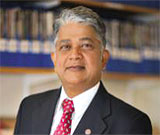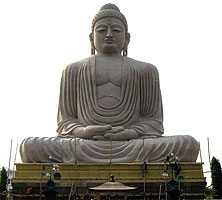A BIHAR OF MY DREAMS
|
|

|
|
By Hari Shanker Sharma
|
|
|
|
Bihar is an important state in India and in terms of population occupies 3rd position in our country. Most of Bihar’s population (56 %) is under the age of 25 years. That is an indicator of a potential youth powerhouse in the country. However, in spite of these positive potentials the state is under-represented in various aspects in our country. Needless to say that the state was once a powerhouse of civilization, education, culture and governance in the world when other parts of the country and Europe, Asia or US were still in primitive conditions. The glorious history of Bihar could be traced back from the prehistoric periods, i.e., Mesolithic period as evidenced by human remains found in
Paisra, Monghyr (Munger) followed by discovery of rock paintings in Kaimur hills, Nawada and
Jamui. The Neolithic settlement was confirmed in Bihar on the bank of Ganges at Chirand (2500-1345 BC). The prehistoric rock paintings in Bihar depicts natural environments e.g., sun, moon, stars, animals and plants and or daily early lives, viz., hunting, running, dancing or walking. These rock paintings were identical to those found in Alta Mira (Spain) or Lascaux (France) as well as in some parts of southern Asia and Africa.
|
|
|
 |
| Bodhgaya, Bihar |
|
|
|
The Ancient Bihar comprising 4 important divisions namely (i) Anga (East Bihar and some parts of present Bengal), (ii) Videha/Mithila (north-eastern Bihar and some parts of current northern Bengal), (iii) Magadha (South Bihar) and (iv) Vaishali (north Bihar) was a center of power, learning and culture in whole Asia. From Bihar’s Magadha the Maurya empire emerged. It was one of the world's most admirable empires and under the Maurya and Gupta dynasties, unified large parts of South Asia under a central rule with its capital Patna (Pataliputra) and became an important center of Indian civilization. With the establishment of Nalanda the center of learning by the 5th century AD in Bihar made this state the most important place of power, culture and education that continued during the next one thousand years. The Gupta Empire, which originated from Magadha in 240 AD, represented the Golden Age of India in science, mathematics, astronomy, religion and Indian philosophy. The Gupta dynasty was contemporary of the Han
Dynasty, Tang Dynasty and Roman Empire as a model of a classical civilization. At this time, Vikramshila (near Bhagalpur) and Nalanda (near Gaya) universities were among the oldest and best centers of education in ancient India.
Now this glorious history of Bihar diminished over time. Even during early 1950s and 60s, Bihar was recognized as one of the best governed states of modern India. However, later in early 70s and 80s the deterioration in our state started and reached its peak during the 1990s-2000. One of the most important reasons for Bihar’s deterioration was division of people in lines of religion and community for the benefit of ruling class at the expense of Bihar’s richness and diversity. The state is known to create leading founders of Buddhism, Jainism and Sikhism and has places of worship of eminence from all religions in the world. Thus, our state is unique and no other state in India or in other parts of the world is so rich in heritage, culture and open mindedness. Nowadays these values of Bihar are systematically destroyed by some vested elements in the name of ruling or governing our state. This division of society must be stopped to bring back the old days of Bihar. Bihar has still the capacity to show new light to the whole world and this should be nurtured well and utilized by the administrators and people alike.
In my view the following 5 key points are necessary to attain the goal of universal leadership of Bihar in modern days that could lead to our states ultimate development in another 100 years:
Excellence in Education
Bihar has a current population of over 100 million distributed across 99,200 square kilometers of the state’s current geographical boundary. On the other hand Sweden, the European Union’s 3rd largest country, has a geographical boundary of 450,295 square kilometers containing only 9.5 million inhabitants. Thus, Bihar has over 10-12 times more population than Sweden. But on the other hand, the availability of schools, colleges, University and higher education facilities is about 100 time less than in Sweden in terms of per capita availability of educational facilities. For example in Sweden there is one University for every 15,000 students. That means over 200,000 students are enrolled in over 14 Universities across Sweden making Sweden 9th on Human Development index in UN Study. In these 14 universities established between 1477 (Uppsala University) and 1993 (mid Sweden University) about 26 Billion SEK (approx. 4 billion USD) is used for research. This makes the literacy rate in Sweden more than 99.3 as compared to India (66.2). This means that all Swedes are highly educated and thus they choose and work carefully for the development of Sweden and the world. I wish that our Bihar state would have a literacy rate of 99.0 % in another century so that this state could be a leading light in India and the world with its own values. To achieve this Bihar needs more funds for education and research so that every child born in Bihar has the right of education in the area he or she should choose. Also, changing subject during g the course should be encouraged to attain full freedom of education and human development. Restrictions don’t make anyone smarter. That means Bihar needs thousands of schools, hundreds of new universities and institutes of higher education in the coming years. Also maintenance of existing educational institutes are equally necessary.
Excellence in Research
Research in every field of education, e.g., humanities, science, medicine, social sciences all are crucial infrastructure of any state. Thus, innovation and research leading to patents and discoveries are badly needed from the soil of Bihar. When we recruit our teachers in higher education we must focus on their capabilities of research and education alike. The nations or states are known by the number of publications in reputed journals that are cited by other contemporary researchers. Number of citations by an author in any country or university certain times in a year gets them most cited person (Institute) certified by Institute of Scientific Information (ISI), USA. About 6 persons in India (out of a billion-plus population) are recognized as highly cited persons. Whereas, in Sweden with 9.5 million people, 65 persons are recognized as highly cited persons. Based on anyone’s citation the Nobel Prize winner Hirsch developed an “H-index”. This H-index denotes roughly x-number of papers cited by x-times each of any author. For example if 5 papers of any author (out of 100) are cited 5 times each, then the author’s H-index would be “5”. According to general practice, a person should be invited to become a faculty member of medical institute (lecturer) if his H-index is 8. When anyone’s H-index reaches 18 only then he is eligible to a full professor in medicine. However, this index varies among subjects, e.g. Physics, where an H-index of 10 could make anyone eligible for a full professor. An H-index over 90 could lead to Nobel Prize in science (as a rough measure). Highest number of H-index in medicine could be 150 to 165 (USA). There are 28 persons who have won the Nobel prize from Sweden in comparison to 8 persons from India who have received this coveted prize. Thus, we want several Nobel prizes from Bihar Universities and for this institutions must be strengthened with human resources and developmental grants. This is a vision that I cherish for Bihar in another 100 years.
Excellence in Governance
All these developments alone could not take place in our Bihar without an effective Government. A transparent Government with lawmakers fully qualified and committed to governance is needed for our Bihar. Ironically enough, we have an examination and competition for clerks in our states but there is no qualification or training is place for lawmakers in Bihar (or India). This needs to be changed, more educated and committed selfless persons are needed to be in Government. When our population is educated these persons will come into governance and make new and long strides for the development of Bihar. So far the new Government is committed and doing excellent work, but the fruit of development should reach all people regardless of community, creed or religion. In such situations, no favor to anyone but simple governance is needed for the upliftment of the masses. I dream to see that this will happen in our Bihar sooner where every citizen will feel secure, prosperous and part of the development process of Bihar.
|
| |
|
—The author is a highly decorated professor of neurosciences at the Uppsala University in Sweden.
He chose to leave Bihar due to lack of facilities for higher research,
but wants to give back to his native state. |
|
|
|
March 2011
|
|


|
|
|
|